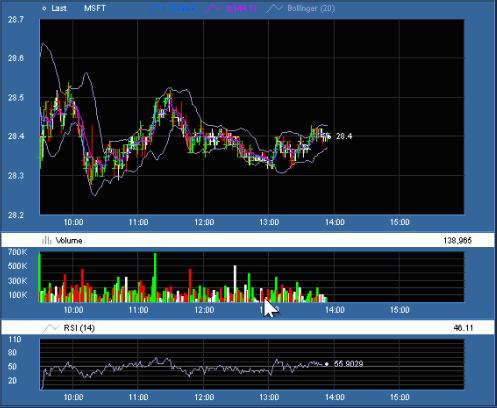Day Trading
Post on: 11 Август, 2015 No Comment

Related Day and Swing Trading articles
Day Trading
Day trading is a system involving many technical tools to complete a round-trip trade (opening and closing a position) within a single trading session.
A round-trip trade consists of two major steps: opening and then closing a position. Day traders may be involved in long positions, short positions, or combinations of both. In a long position, the series of steps is buy-hold-sell; with a short position, it is the reverse, or sell-hold-buy.
In all trades, the first step is the opening order and the last step is the closing order. These are further distinguished by whether either of these is long or short.
An opening order creates either a buy (long) or a sell (short) action. So the distinction buy to open/sell to open is critical to ensuring that orders are placed properly. On the closing side, the distinction is just as important. So sell to close/buy to close also instructions the broker to enter the order you intend to place.
Key Point
Day traders prefer closing positions the same day opened, out of concern for potential price diff erences between todays close and tomorrows open.
Day traders have to be familiar with the range of opening and closing orders so that they can avoid placing an order of the wrong type. In addition to mastering order placement terminology, day traders use a series of valuable technical analysis tools, all aimed at helping them to spot trend strength, weakness and reversals, increasing or decreasing momentum, and related volume indicators that help the timing of day trades.
Key Point
Specific price patterns and changes spark swing trading action, based on short-term trends and reversals.
These technical tools can involve a large number of possible indicators. The most popular and most frequently used are:
- Charts. Indicators most often are spotted visually (even indexed or percentage-based indicators are also charted along with price). Of the many kinds of charts available, candlesticks are becoming very popular with traders (see Chapter ). These charts provide all of the information about price movement in a single formation: opening and closing price, the sessions trading range, and the direction of price movement. The shape of candlesticks is also significant and when two or more sticks are analyzed together, specific patterns provide strong clues about reversal (or continuation) most likely to follow.
- Moving average (MA) analysis. The moving average is among the most important of technical tools, and day traders more than most technical analysts rely on MA to spot strength or weakness in the current trend. Among the MA analysis is the use of two MA lines of different duration. For example, watching the movement in a 20-day and a 200-day MA is revealing. The convergence/divergence of the MA lines tells the technician when price is likely to reverse directions. A popular variation of this is called MACD, which is an acronym for moving average convergence/divergence.
- Breadth of trading range analysis. The trading range is the key to most forms of technical analysis. As this breadth changes, it holds great significance. A broadening breadth reveals growing price volatility; a narrowing breadth tells you two things. First, volatility is declining; second, a reversal from the current trend is quite likely. Chapter includes an explanation of this indicator.
- Support- and resistance-based analysis. Also in chapter is an explanation of a range of popular and valuable technical indicators. The importance of support and resistance is central to all types of technical indicators, and for day traders, these bottom and top trading levels help define risk and potential profits or losses in a short-term strategy.
Day traders use a specific type of strategic timing approach to the market. However, even traders who hold positions open beyond a single trading session most often use the same strategies, but across a less frantic pace. Day traders are specifically associated with some focused trading activities.
Key Point
Variations in day trading include very specific recognition tools; variations in day trading extend beyond single-session open and close activity.
The first style is called intra-day trading. A day trader normally opens and closes a position in a single day. The intra-day trader might do the same, or leave a position open until the following session. The usual pattern is for the position to remain open for a period of time between a few minutes and two trading sessions.

Day traders rely on a series of specific entry and exit signals, which are explained later in Entry and Exit Signals. A variation of this approach is momentum trading. Under this system, trades are opened and then closed based on a short-term trend (this may last only a matter of minutes, or for entire trading day). The ideal momentum trade is made at the beginning of the trend and then closed as soon as momentum becomes exhausted or reverses.
Why is momentum trading any different from other approaches to day trading? Momentum traders act specifically on perceived direction of price, and on slowing down of the pace as a reversal and exit signal. A momentum trader is also likely to analyze price trends using extremely short trading increments, such as five-minute charts. In comparison, other day traders are likely to study price patterns and tests of support and resistance to find entry and exit points, and may use charts taking more time, such as one-hour charts, for example. The momentum trader only tracks the direction of price, and other day traders are likely to seek patterns anticipating reversal before it actually occurs.
Key Point
Day and swing traders look for specific price-related patterns. Momentum traders focus on price direction and strength of timing movement.
Another advanced system, one used by momentum traders and other day traders, is to analyze the price action within a single day using multiple time increments. For example, you might combine analysis using 5-minute, 15-minute, and 60-minute charts. This achieves multiple views of the same price, based on the fact that some developing reversal points may be hidden in the longer-duration charts but show up in the 5- or 15-minute versions of the same stock. Chartists who watch two or three different charts at the same time understand that price patterns form in all time increments, and they want to be sure they have all of the visual tools possible. A trader using this strategy is also likely to move in and out of positions more frequently than other day traders, based mostly on changes in momentum.
The desire to close positions before the end of the trading day is characteristic of day traders. The criticism that this avoids the legal margin requirements is part of the reason, but not the primary reason that day traders want to move in and out before trading stops. Most day traders do not want to leave their positions open overnight based on the fear that big changes can occur from one session to the next.
In a nicely ordered world, a stock would open close to the price it closed the day before. However, with growing interest in after-hours trading, this is not a certainty. Companies also tend to make earnings and other announcements after the close of trading just to avoid a big impact on the stocks price on the day the announcement is made. So day traders have a point in wanting to be out of open positions; there are just too many variables that can develop. The chance of a big price change between todays close and tomorrows open is a very real possibility.
Key Point
Yesterdays close and tomorrows open are not always the same, and often are not even close. This provides a clue about why day traders are concerned about leaving positions open overnight.
Unlike the buy-and-hold investor who thinks in terms of years, traders think in terms of minutes or hours and act accordingly. Over recent years, the average holding period of positionsincluding both investors and tradershas been on the decline. Figure below demonstrates the history of average holding periods since 1920.
Average holding period, stocks.
The trend demonstrated that between 1945 and 1980, the buy-and-hold philosophy reigned within the stock market, and then declined rapidly. Today, trading has replaced a lot of the traditional strategies that value investing supportseven in spite of the successful track record of the buy-and-hold approach.
The causes of these changes, notably after 1975, are varied. Before 1975, average holding period was higher than four years each and every year. From 1980 onward, the average fell below three years and remained there. In 2005, for the first time, the average holding period was less than one year. The Internet has made trading easier than ever before, explaining a part of the trend since 2000; but the trend predates the Internet, so a broader trend has been underway. It might be related to the timing of major market primary trends. For example, after the 1929 crash, average holding period rose until 1945, after which the decline began.
Key Point
A long-term trend in the market is for stock holding periods to decline over time. Most recently, the average has fallen below one year for the first time.
Whatever the cause, the value investing philosophy of buy and hold has lost popularity in recent years and activities like day trading have become increasingly popular. This trend might provide clues to what is going to happen in the future. Investors and traders both play a role in influencing long-term price trends of individual stocks and of the entire market; but no one can say with certainty which group will prevail in future years.
Day traders, like long-term investors, understand the adage that the trend is your friend. The timeframe, however, is quite different. Buy-and-hold proponents may criticize the extremely short-term mindset of the day trader by expanding the adage to the trend is your frienduntil the end. In other words, an accumulation of small, rapid profits can be wiped out in one ill-timed move.














